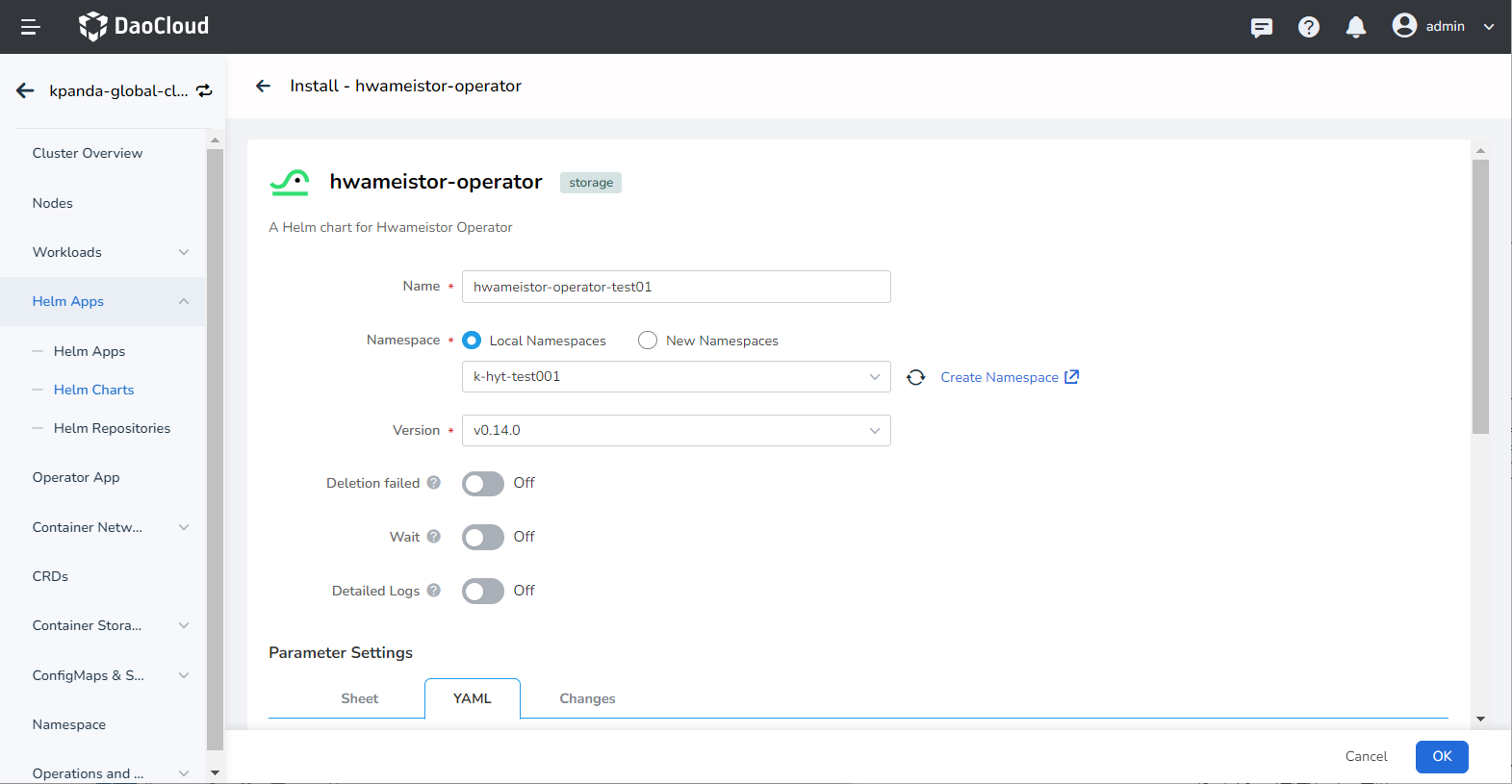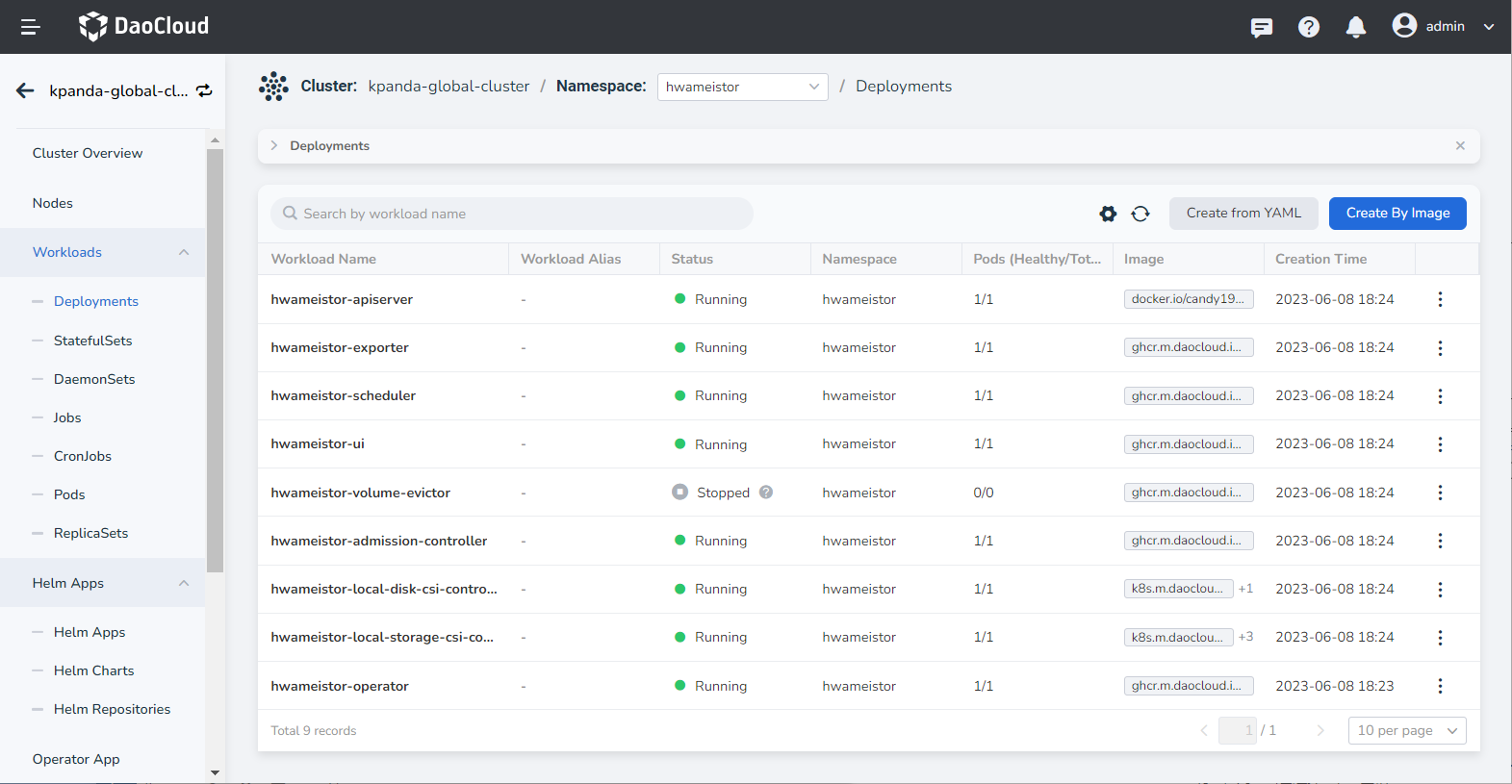Install with Operator¶
This article introduces how to install Hwameistor through the Hwameistor Operator on the platform interface. After installing the Operator, it will automatically launch the Hwameistor-related components. The HwameiStor Operator is responsible for the following:
- Full lifecycle management (LCM) of all components:
- LocalDiskManager
- LocalStorage
- Scheduler
- AdmissionController
- VolumeEvictor
- Exporter
- Apiserver
- Graph UI
- Configuring node disks for different purposes and use cases
- Automatically discovering the type of node disks and creating HwameiStor StorageClass accordingly
- Automatically creating corresponding StorageClasses based on the configuration and features of the HwameiStor system
Prerequisites¶
- Nodes intended for use with Hwameistor must have sufficient free HDD and SSD disks.
- Ensure that all prerequisites in the Preparation documentation are met.
- If you plan to use highly available data volumes, complete the DRBD installation process beforehand.
- If deploying to a production environment, please review the Resource Requirements for Production Environment documentation beforehand.
- If your Kubernetes distribution uses a different
kubeletdirectory, confirm thekubeletRootDirparameter beforehand. For more details, refer to Customize Kubelet root directory.
Info
If there are no available clean disks, the Operator will not automatically create a StorageClass. During the installation process, the Operator will automatically manage the disks and add available disks to the pool of LocalStorage. If the available disks are provided after the installation, you need to manually issue a LocalDiskClaim to manage the disks in LocalStorageNode. Once there are disks in the pool of LocalStorageNode, the Operator will automatically create the StorageClass. In other words, if there is no capacity, the StorageClass will not be created automatically.
Steps¶
Ensure that your cluster has successfully connected to the container management platform before proceeding with the following steps to install Hwameistor.
-
In the left navigation bar, click
Container Management->Cluster List, and find the name of the cluster where Hwameistor will be installed. -
In the left navigation bar, select
Helm Apps->Helm chart, find and clickHwameistor Operator.
-
Within the
Version Selectionsection, choose the version to install, and then clickInstall. -
On the installation interface, fill in the required installation parameters.

The parameters in
Value.yamlare as follows and can't be modified by default:global: targetNamespace: hwameistor hwameistorImageRegistry: ghcr.io k8sImageRegistry: registry.k8s.io hwameistorVersion: v0.9.2 operator: replicas: 1 imageRepository: hwameistor/operator tag: '' localDiskManager: tolerationOnMaster: true kubeletRootDir: /var/lib/kubelet manager: imageRepository: hwameistor/local-disk-manager tag: '' csi: registrar: imageRepository: sig-storage/csi-node-driver-registrar tag: v2.5.0 provisioner: imageRepository: sig-storage/csi-provisioner tag: v2.0.3 attacher: imageRepository: sig-storage/csi-attacher tag: v3.0.1 localStorage: tolerationOnMaster: true kubeletRootDir: /var/lib/kubelet member: imageRepository: hwameistor/local-storage tag: '' csi: registrar: imageRepository: sig-storage/csi-node-driver-registrar tag: v2.5.0 provisioner: imageRepository: sig-storage/csi-provisioner tag: v2.0.3 attacher: imageRepository: sig-storage/csi-attacher tag: v3.0.1 resizer: imageRepository: sig-storage/csi-resizer tag: v1.0.1 monitor: imageRepository: sig-storage/csi-external-health-monitor-controller tag: v0.8.0 scheduler: imageRepository: hwameistor/scheduler tag: '' admission: imageRepository: hwameistor/admission tag: '' evictor: imageRepository: hwameistor/evictor tag: '' apiserver: imageRepository: hwameistor/apiserver tag: '' exporter: imageRepository: hwameistor/exporter tag: '' ui: imageRepository: hwameistor/hwameistor-ui tag: '' ha: module: drbd deployOnMaster: 'yes'-
hwameistorImageRegistry:Set the registry address of the Hwameistor mirror, and the available online registrys have been filled in by default. If it is a privatized environment, it can be modified to a private registry address.
-
K8s container registry:Set the address of the K8S container registry, and the available online registry has been filled in by default. If the environment is privatized, it can be modified to a private registry address.
-
-
After confirming that the parameters are correct, click
OKto complete the installation. After the installation is complete, you can clickHelm Appsto view the installation status ofHwameistor Operator.
-
After the Operator is installed, the Hwameistor components (Local Storage, Local Disk Manager, etc.) will be installed by default! You can click
Workload→Stateless Workload, select the corresponding namespace, and view the status of the Hwameistor component.
To verify the installation effect through the command line, please refer to Post-installation Check.